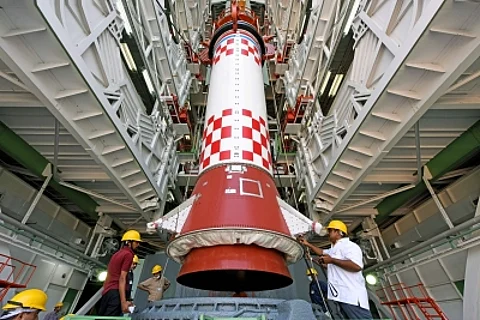On its first developmental flight, the SSLV-D1 carried an earth observation satellite-02 (EOS-02), formerly known as microsatellite-2, weighing about 145 kg, and the eight kg AZAADISAT built by 750 students of government schools facilitated by SpaceKidz India.
About 12 minutes into the rocket's flight, ISRO announced the separation of EOS-02 and the AZAADISAT.
Soon after that, a heavy silence came about the Mission Control Centre at the rocket port here with Somanath announcing: "The SSLV-D1 mission was completed. All the stages of the rocket performed as expected. There is some data loss in the terminal stage of the rocket."
He said that data is being gathered to know the status of the mission.
"The AZAADISAT got separated. We can know about the satellite only at night," Dr. Srimathy Kesan, Founder and CEO, SpaceKidz India told IANS.
At about 9.18 a.m. the rocket broke free of the first launch pad here and went up into a cloudy sky. The rocket's progress was smooth with all its solid fuel-powered engines performing well.
The three-staged SSLV-D1 is primarily powered by solid fuel (total of 99.2 tons) and also has a velocity trimming module (VTM) powered by 0.05 tons of liquid fuel for precise injection of satellites.
India's newest rocket was 34 meters tall and weighed 120 tons.
As per the flight plan, just over 12 minutes into its flight, the SSLV-D1 was to deliver into space the EOS-2 satellite and then the AZAADISAT a few seconds later. However, this did not go according to plan.
According to the ISRO, the SSLV is ready to transfer rockets with modular and unified systems with standard interfaces for production by the industry.
The SSLV design drivers are low-cost, low turnaround time, flexibility in accommodating multiple satellites, launch-on-demand feasibility, minimal launch infrastructure requirements, and others, ISRO said.
The commercial arm of ISRO, NewSpace India Ltd, was planning to transfer the SSLV technology for production in the private sector after a couple of successful missions.
The Indian space agency said the EOS-02 satellite is an experimental optical imaging satellite with high spatial resolution. The objective is to realize and fly an experimental imaging satellite with a short turnaround time and showcase launch on-demand capability.
The launch of small satellites will be a dominant factor in the global space sector with about 7,000 satellites expected to be up in the sky by 2027, V.K. Saraswat, a member, of Niti Aayog said at a space seminar.
In all, about 7,000 small satellites are expected to be launched between 2018 and 2027 with a total value of $38 billion, Saraswat said. (AA/IANS)


